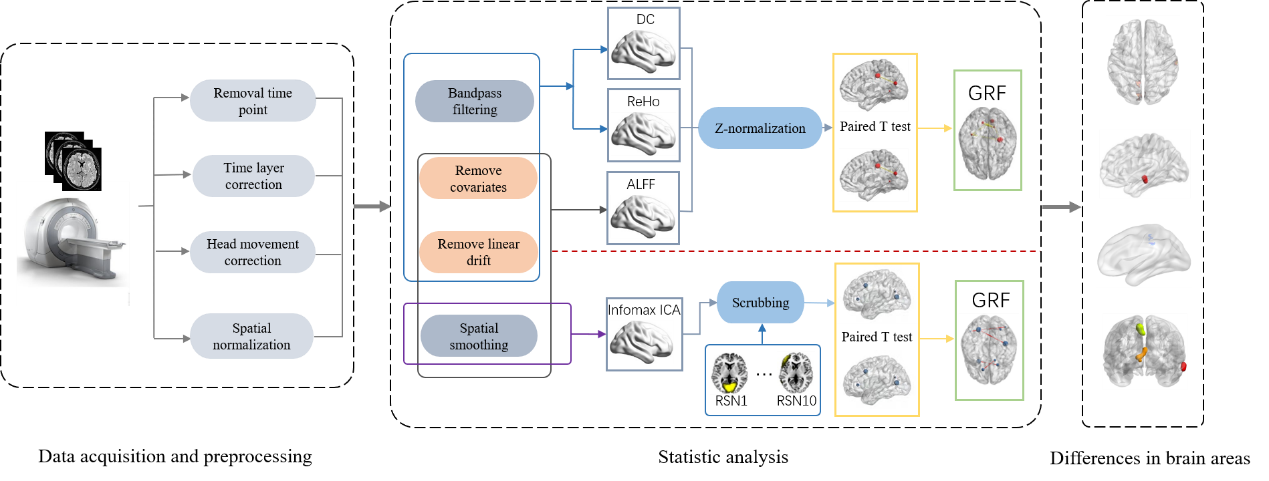研究中心硕士袁航的一篇论文“Research on resting spontaneous brain activity and functional connectivity of acupuncture at uterine acupoints”被Digital Chinese Medicine刊发。(论文链接地址:https://doi.org/10.1016/j.dcmed.2022.03.006)

【摘要】目的:采用静息状态功能磁共振成像(rs-fMRI)分析方法,研究电针刺激双侧子宫穴(EX-CA1)引发的大脑活动及其功能连接情况,探究针刺子宫穴治疗妇科疾病的作用机制。方法:电针刺激22名健康女性被试者的双侧子宫穴,对被试脑部fMRI数据做标准化预处理;采用度中心性、低频波动振幅和局部一致性方法,分析被试针刺前后的局部自发性脑活动;采用基于独立成分分析的功能连接分析方法,研究针刺前后静息态脑网络的连接情况。
结果:局部自发性脑活动分析方法发现,与针刺前相比,针刺后受试者楔前叶、眶额皮层、舌回、杏仁核以及中央后回的神经活动强度降低(voxel P < 0.001, cluster P < 0.05);功能连接分析方法发现,听觉网络和右侧额顶网络功能连接减弱(voxel P < 0.001, cluster P < 0.05),视觉网络功能连接增强(voxel P < 0.001, cluster P < 0.05),并且在听觉网络和视觉网络中发现下丘脑-垂体系统被协同激活。结论:研究结果表明针刺子宫穴前后,部分脑区的神经活动及功能连接存在明显差异,并且下丘脑-垂体系统的不同脑区也出现了不同的活跃状态。据此推测可知针刺子宫穴的作用机制与大脑调节生殖激素水平、情绪变化及躯体感觉有关。研究设计的脑影像分析方法,可在一定程度上阐明针刺子宫穴治疗妇科疾病的神经作用机制,并为针刺其他穴位的机制研究提供了可借鉴的分析方法。
[Abstract]Objective: The resting-state functional magnetic resonance imaging (rs-fMRI) method was used to observe brain activity and its functional connection upon electroacupuncture stimulation at bilateral uterine acupoints (EX-CA1), as well as to investigate the mechanism of acupuncture in the treatment of gynecological diseases. Methods: Twenty-two healthy female subjects were stimulated by electroacupuncture at bilateral uterine acupoints; rs-fMRI data of the brain were acquired and standardized. Degree centrality (DC), regional homogeneity (ReHo), and amplitude of low-frequency fluctuation (ALFF) were used to analyze local spontaneous brain activity via acupuncture. An independent component analysis was used to evaluate the functional connectivity of the resting brain networks after acupuncture. Results: Analytical results showed that the neural activity intensity of the precuneus lobe, orbitofrontal cortex, lingual gyrus, amygdala, and posterior central gyrus decreased after acupuncture (voxel P < 0.001, cluster P < 0.05). Functional connectivity analysis revealed weakened auditory and right frontal-parietal networks (voxel P < 0.001, cluster P < 0.05), enhanced visual network, and synergistic auditory network and hypothalamic-pituitary system (voxel P < 0.001, cluster P < 0.05). Conclusion: Significant differences in neural activity and functional connectivity in specific brain regions were observed after acupuncture intervention at uterine acupoints; the hypothalamic-pituitary system also showed various active states in different brain regions. It is speculated that the effective mechanism of acupuncture at uterine acupoints is related to the regulation of reproductive hormones, emotional changes, and somatic sensations. Therefore, the methods used in this study could clarify the neural mechanism of uterine-point acupuncture in the treatment of gynecological diseases and may serve as a reference for other studies pertaining to acupuncture.